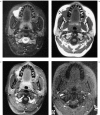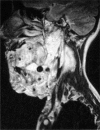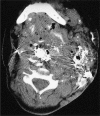Cervicofacial venous malformations. MRI features and interventional strategies
- PMID: 20594480
- PMCID: PMC3572475
- DOI: 10.1177/159101990200800302
Cervicofacial venous malformations. MRI features and interventional strategies
Abstract
We retrospectively evaluated 53 consecutive patients with cervicofacial venous malformation who had sclerotherapy. This review included a demographic analysis, MRI reexamination and tabulation of interventional therapeutic strategies. All patients whose MRI studies were included in this review demonstrated characteristic findings: space occupying lesion with hyperintense T2 signal abnormality, patchy contrast enhancement, and no flow signal on the gradient echo images.We concluded that a complete MRI work-up of these patients requires post-contrast scanning and gradient-echo imaging in addition to the standard T1 and T2 weighted spin echo imaging. The majority of patients had sporadic (non-familial) venous anomalies. Sinus pericranii (SP) was identified in six patients (11%) and blue rubber bleb nevus syndrome (BRBNS) was found in two patients (4%). MRI findings of sinus pericranii are discussed in detail. Although sodium tetradecyl and/or absolute ethanol are the most commonly used sclerosants, a wide variety of therapeutic strategies (depending on the nature of the abnormality) are also needed for these patients.
Figures





References
-
- Robertson RL, Robson CD, et al. Head and neck vascular anomalies of childhood. Neuroimaging Clin N Am. 1999;9(1):115–132. - PubMed
-
- de Lorimier AA. Sclerotherapy for venous malformations. J Pediatr Surg. 1995;30(2):188–193. - PubMed
-
- Seccia A, Salgarello M. Treatment of angiomas with sclerosing injection of hydroxypolyethoxydodecan. Angiology: 1991;42(1):23–29. - PubMed
-
- Mulliken JB, Fishman SJ, Burrows PE. Vascular anomalies. Curr Probl Surg. 2000;37(8):517–584. - PubMed
-
- Mulliken JB, Young AE. Vascular birthmarks: haemangiomas and malformations. Philadelphia: Saunders; 1988.
LinkOut - more resources
Full Text Sources

